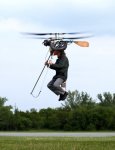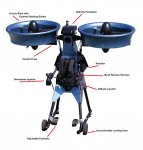Agree
Agree
I totally agree, brett.
But I have NEVER labelled that type of rotor craft the "most safe rotor craft in the world". Read last line in my post #51.
If you build from the following rules and use it that way, you can have the most safe rotor craft in the world - I think:
1. Coaxial is almost the only way to go.
2. COG of machine and COG of body has to be in line with rotor C/L.
3. A landing gear on machine combined with using ones legs.
4. Fly low and slow – as Franz Schoefman.
________________________________________________________
I know very well how much back machine it is funny to have on your back.
I have had hundreds of starts and landings with a ‘backpack machine’, and I just test flew my new machine this Sunday in Denmark.
Dry weight of my old homebuilt machine was 30 kg. The new kit build machine 24 kg, and with fuel 30 kg, and that’s enough.
I totally agree that twice the weight on your back and 2 spinning props/rotors on top is very dangerous and a HUGE design flop.
Here is a picture taken yesterday here in Norway, of my new machine and my not so new body

:
(More pictures:
http://www.flyvglider.dk/forum/forum_posts.asp?TID=256&PN=1&TPN=1 )







